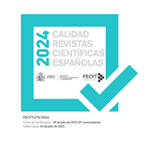Diferencias lingüísticas y diferencias simbólicas en el discurso de jóvenes ecuatorianos en Madrid
Resumen
Si bien una de las características de los colectivos sociopolíticos tiene que ver con el hecho de que en general se trata de grupos construidos en el sentido de que no son naturales (“imagined communities”, Anderson, 1983), las diferencias observadas entre ellos les confieren al menos cierta ilusión de realidad, llegando incluso algunas de ellas a dibujar fronteras que se pueden interpretar de manera más o menos objetiva, es decir que inducen a concebir los colectivos asociados a ellas en términos naturales. Con todo, al lado de este tipo de fronteras que ignoran la diversidad inherente en cualquier grupo (Ambadiang, Palacios y García Parejo, 2008), cabe imaginar otras fronteras, de naturaleza menos estática y más acorde con la dinámica característica de las situaciones de contacto. De acuerdo con esta última perspectiva, nos proponemos indagar en la relevancia que tienen tanto las propias diferencias lingüísticas y culturales como su uso en la construcción de la identidad individual y colectiva por parte de los jóvenes ecuatorianos residentes en un contexto muy específico de contacto: Madrid. A partir de la narración que se recoge en las respuestas abiertas en un cuestionario aplicado a 56 estudiantes ecuatorianos de Educación Secundaria intentamos determinar cómo construyen discursivamente su identidad social, así como el papel que desempeña la variación lingüística en este proceso. Nuestros datos sugieren que los procesos de categorización de los jóvenes ecuatorianos se distribuyen alrededor de tres estrategias básicas que pasan por considerar al colectivo español como: (i) una mera comparación; (ii) una fuente de categorizaciones, generalmente negativas; y (iii) una imagen especular.Descargas
Descarga artículo
Licencia
La revista Círculo de Lingüística Aplicada a la Comunicación, para fomentar el intercambio global del conocimiento, facilita el acceso sin restricciones a sus contenidos desde el momento de su publicación en la presente edición electrónica, y por eso es una revista de acceso abierto. Los originales publicados en esta revista son propiedad de la Universidad Complutense de Madrid y es obligatorio citar su procedencia en cualquier reproducción total o parcial. Todos los contenidos se distribuyen bajo una licencia de uso y distribución Creative Commons Reconocimiento 4.0 (CC BY 4.0). Esta circunstancia ha de hacerse constar expresamente de esta forma cuando sea necesario. Puede consultar la versión informativa y el texto legal de la licencia.











